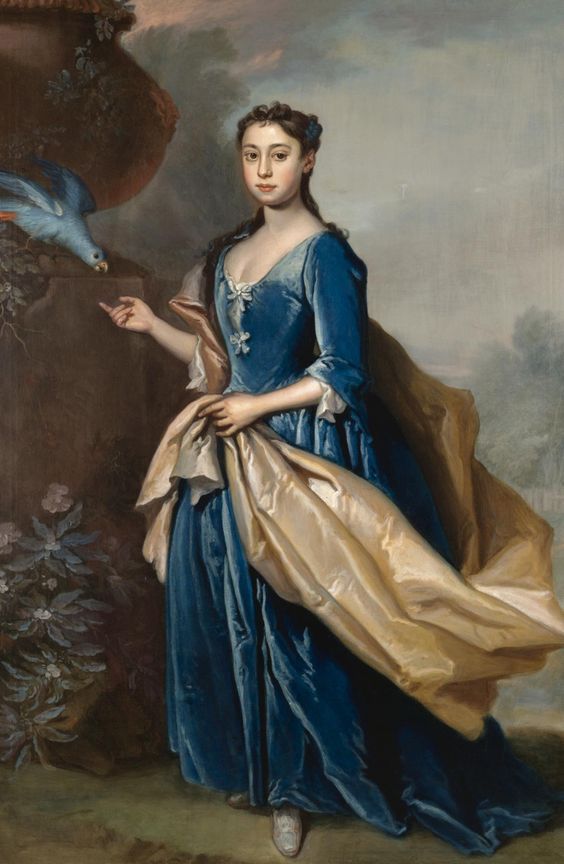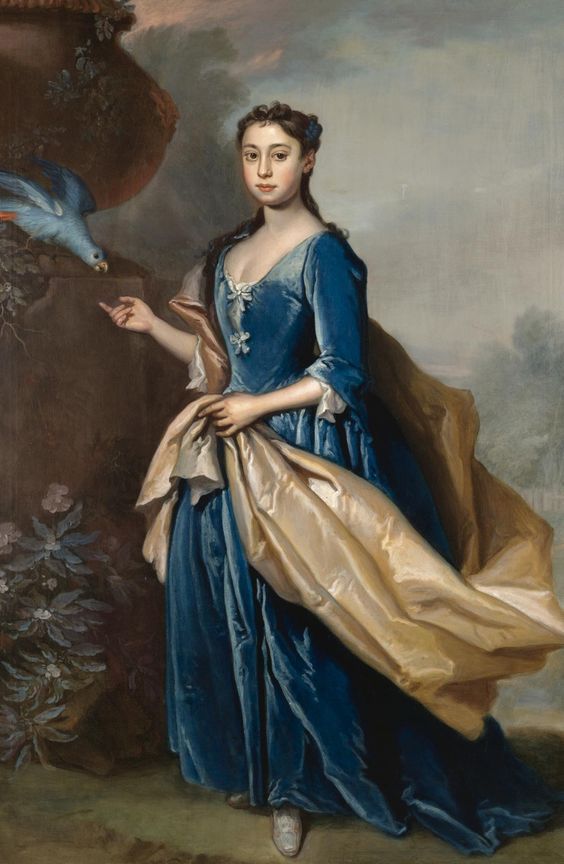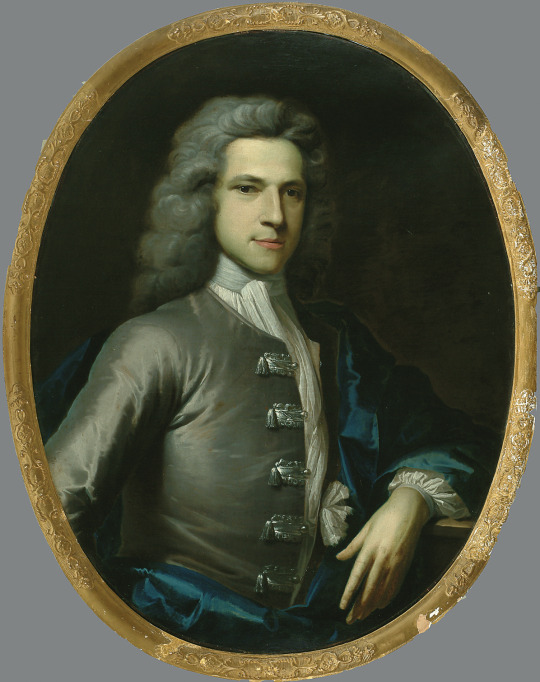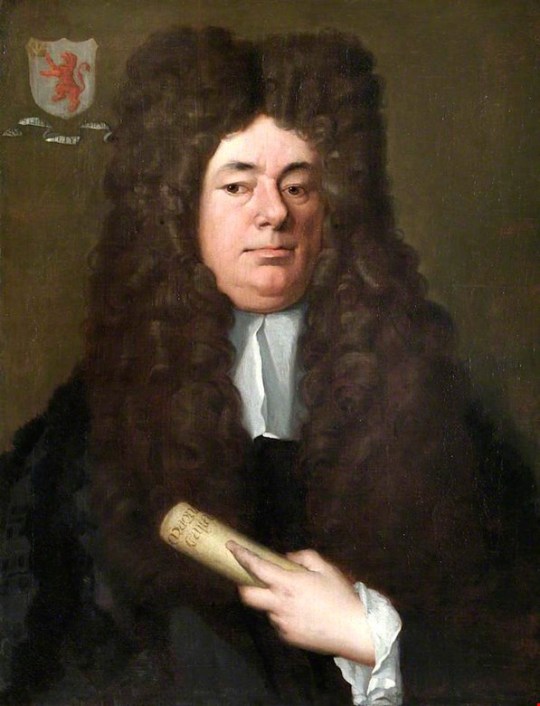#richard van bleeck
Text

Richard van Bleeck and Coenraet Roepel - Coenraet Roepel (1678-1748), painting a still-life -
oil on canvas, height: 110.5 cm (43.5 in); width: 87.2 cm (34.3 in)
Richard van Bleeck (1670–1733) was a Dutch Golden Age painter.
Coenraet Roepel (1678, The Hague – 1748, The Hague), was an 18th-century fruit and flower still life painter from the Northern Netherlands.
According to Jan van Gool he was an avid gardener and his love of flowers made him become a pupil of Constantijn Netscher so that he could paint the flowers and other plants in his garden. He travelled to Düsseldorf in 1716 and received a gold chain and medal from Johann Wilhelm, Elector Palatine for his work. He had high hopes of painting more for the elector, but his patron died the same year, so Coenraet returned to the Netherlands. On his return, he became a member of the Confrerie Pictura in 1718 and was very successful in The Hague, receiving as much as 1,000 guilders for a work, but was later eclipsed by the flower painter Jan van Huysum.
According to the RKD he was trained in the Confrerie in the years 1698-1699 and first became a member there in 1711. His pupil was Pieter Terwesten.
The Lazaro Galdiano Museum in Madrid owns a couple of Still lifes, one with fruits and the other a Vase with Flowers, from Roepel.
31 notes
·
View notes
Photo

Portrait of a lady in a blue dress, attributed to Richard van Bleeck
394 notes
·
View notes
Photo

Portrait of a lady in a blue dress, attribued to Richard van Bleeck (c. 1670-c. 1733)
13 notes
·
View notes
Photo

1719 Richard van Bleeck - Paulus Akersloot
(Frans Hals Museum)
100 notes
·
View notes
Photo

Portrait of a lady in a blue dress, attribued to Richard van Bleeck (c. 1670-c. 1733)
100 notes
·
View notes
Photo

Richard van Bleeck
Portrait of the artist Coenraet Roepel
#richard van bleeck#coenraet roepel#portrait#artist#painter#easel#paintbrush#palette#colour#painting#flowers#studio#atelier#baroque#art
34 notes
·
View notes
Text

Richard van Bleeck - Portrait of Sir John Holt - ca. 1700
oil on canvas, height: 124.5 cm (49 in) Edit this at Wikidata; width: 99.7 cm (39.2 in)
National Portrait Gallery, London, UK
Sir John Holt (23 December 1642 – 5 March 1710) was an English lawyer who served as Lord Chief Justice of England from 17 April 1689 to his death. He is frequently credited with playing a major role in ending the prosecution of witches in English law.
Historian John Callow argues in his 2022 book, The Last Witches of England, that sceptical jurists, especially Holt, had already largely stopped convictions for witchcraft under English law even before the Witchcraft Act 1735 finally concluded such prosecutions. Callow particularly credits Holt with great courage in doing so in the face of religious pressure, mob violence, and popular superstitious belief in witchcraft.
The Witchcraft Act 1735 (9 Geo. 2. c. 5) was an Act of the Parliament of the Kingdom of Great Britain in 1735 which made it a crime for a person to claim that any human being had magical powers or was guilty of practising witchcraft. With this, the law abolished the hunting and executions of witches in Great Britain. The maximum penalty set out by the Act was a year's imprisonment.
It thus marks the end point of the witch trials in the Early Modern period for Great Britain and the beginning of the "modern legal history of witchcraft", repealing the earlier Witchcraft Acts which were originally based in an intolerance toward practitioners of magic but became mired in contested Christian doctrine and superstitious witch-phobia. Instead of assuming as the earlier laws did that witches were real and had real magical power derived from pacts with Satan, the new law assumed that there were no real witches, no one had real magic power and those claiming such powers were cheaters extorting money from gullible people.
The law was reverting to the view of the primitive and the medieval Church, expressed from at least the 8th century, at the Council of Paderborn, but contested by witch-phobic Dominican Inquisitors beginning in the mid 15th century, with some success in forwarding a new doctrine among the popes, as seen in the papal bull Summis desiderantes affectibus (1484), but with far less success among the bishops. Thus the Act of 1735 reflected the general trend in Europe, where after a peak around 1600, and a series of outbursts in the late 17th century, witch-trials quickly subsided after 1700. The last person executed for witchcraft in Great Britain was Janet Horne in 1727.
In the early modern period, witch trials were seen between 1400 and 1782, where around 40,000 to 60,000 were killed due to suspicion that they were practicing witchcraft. These trials occurred primarily in Europe, and were particularly severe in some parts of the Holy Roman Empire. Some witch-hunts would last for years, and some sources estimate 100,000 trials occurred. Groundwork on the concept of witchcraft (a person's collaboration with the devil through the use of magic) was developed by Christian theologians as early as the 13th century. However, prosecutions for the practice of witchcraft reached a high point only from 1560 to 1630 during the Counter-Reformation and the European wars of religion, with some regions burning at the stake those who were convicted, of whom roughly 80% were women, mostly over the age of 40.
Richard van Bleeck (1670–1733) was a Dutch Golden Age painter.
19 notes
·
View notes
Text

Richard van Bleeck - Walter Aston, 4th Lord Aston, His Wife Mary and Their Seven Children - ca. 1725
Richard van Bleeck (1670–1733) was a Dutch Golden Age painter.
15 notes
·
View notes
Text

Richard van Bleeck - Portrait of Sylvester Petyt - ca.1710
oil on canvas, height: 124.5 cm (49 in); width: 100.3 cm (39.4 in)
National Portrait Gallery, London, UK
Richard van Bleeck (1670–1733) was a Dutch Golden Age painter.
He was born in The Hague. According to the Netherlands Institute for Art History, he was the pupil of Theodor van der Schuer and Daniel Haringh. He became a portrait painter and painted the portrait of the engraver Coenraet Roepel, before moving to London in 1733, where he stayed. He was the father of Pieter van Bleeck, who was born in the Hague, possibly moved with him to London and also became a portrait painter there.
8 notes
·
View notes
Text

Richard van Bleeck - William Petyt Holding a Copy of the Magna Carta - c 1690
oil on canvas, height: 74 cm (29.1 in); width: 60 cm (23.6 in)
Tower of London, UK
William Petyt (or Petit) (1640/1641 – 3 October 1707) was an English barrister and writer, and a political propagandist in the Whig interest.
Petyt was born in 1640 or 1641 in the village of Storiths, near Bolton Abbey, Skipton, Yorkshire, and educated at the Free Grammar School (now Ermysted's Grammar School), Skipton, and Christ's College, Cambridge. He was admitted as a barrister to the Middle Temple in June 1660, and to Barnard's Inn in June 1661. He was specially admitted to the Inner Temple on 25 November 1664, and subsequently called to the Bar there in February 1671 and made a bencher in 1689. He served as Treasurer (that is, the head) of Inner Temple in 1701–1702.
On 25 July 1689, Petyt was appointed Keeper of the records at the Tower of London by William III, replacing in that position Robert Brady who had made a very effective attack for the Tories on Petyt's The Antient Right of the Commons of England Asserted (1680).[6] Petyt was attacked also from his own side, the Whigs, by Thomas Hunt.
Petyt wrote against the separation of powers, and in favour of Parliament's control of the judiciary. Influential in its time, in particular on John Locke, was a version of "ancient constitutionalism" propounded in the writings of John Sadler, James Tyrrell and Petyt.
Petyt died unmarried in Chelsea, London, on 3 October 1707, and was buried in the west part of Temple Church. In his will he left £50 to the Free Grammar School in Skipton which was used to purchase books for needy students. He also left £200 for the maintenance of alumni of the Free Grammar School who had been admitted as scholars at Christ's College, Cambridge. In addition, he entrusted to his trustees his books and manuscripts together with £150 for buying or building a place to preserve them. Inner Temple Library was enlarged for this purpose, and in 1708 Petyt's trustees deposited his collection there, except for about 2,000 items which his brother Sylvester (1640–1719) took to his home in Yorkshire. Sylvester, who also attended the Free Grammar School, eventually bequeathed to the school the generous sum of £30,000 to form the Petyt Trust, and also books belonging to himself, his brother and friends which became the Petyt Library.
Richard van Bleeck (1670–1733) was a Dutch Golden Age painter.
14 notes
·
View notes
Photo

1715-1730 Richard van Bleeck - Dammas Akersloot
(Frans Hals Museum)
63 notes
·
View notes
Photo

1732 Richard van Bleeck - Portrait of a Boy with Parrot
(Private collection via Christie’s)
58 notes
·
View notes